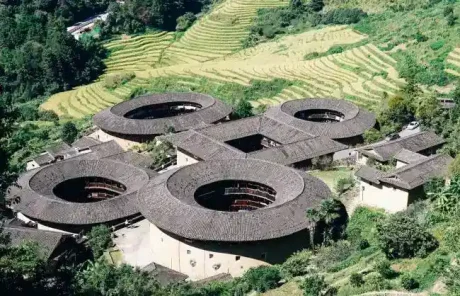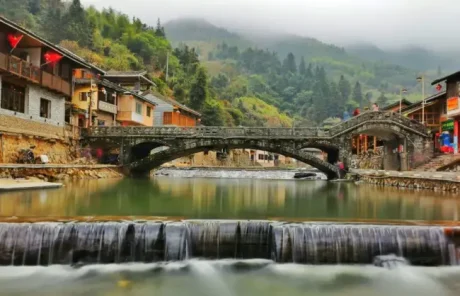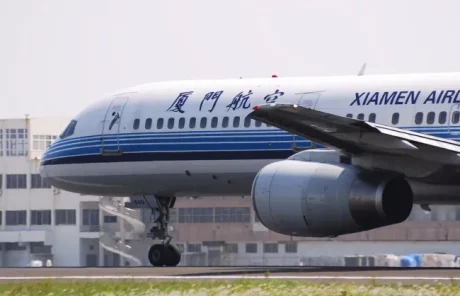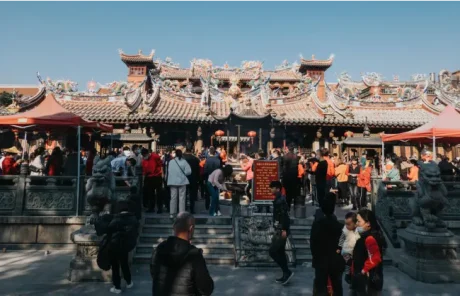Fujian Tulou Travel Guide – Explore Secrets of Traditional Fujian Dwellings
Fujian Tulou, aka Hakka Tulou or Hakka earth building, is a form of traditional residential architecture constructed by the Hakka people in Fujian. Currently, most of these Tulou houses are concentrated in Yongding County and Nanjing County. You may also encounter these Tulou houses in other regions of Fujian and parts of Guangzhou.
Thanks to its unique architectural design and profound cultural significance, Fujian tulou was included in the UNESCO World Heritage List in 2008. Now, the tulou houses have become such a popular destination that most travelers like to include a Fujian tulou tour in their Xiamen travel or Fujian travel itinerary.
The origination of the Fujian Tulou complex can be traced back to the Song and Yuan Dynasties. To adapt to mountainous environments and defensive needs, the Han Chinese migrants developed this kind of unique architecture by using basic building materials such as earth, wood, stone, and bamboo.
These buildings are for collective living, mostly rising two to three stories (some can reach four or five stories), and coming in various shapes. A smaller tulou building can house a few dozen families, while the large ones can accommodate hundreds or even thousands of residents. The square and circular tulous are the most numerous in Fujian, and other less common tulou shapes include elliptical, pentagonal, mansion-style, etc.

Chinese: 土楼 tǔ lóu
Distributed in: Yongding, Nanjing, Hua’an…
Why Visit Fujian Tulou?
- A UNESCO-listed Cultural Heritage: An outstanding representative of ancient architecture in China, tulou houses attract worldwide visitors with their unique architectural forms and rich history.
- Impressive Architectural Ingenuity: The buildings are eye-catching for their grand scale, intricate structures, and ingenious design blending defense and living spaces.
- Rich Hakka Culture Experiences: Beyond the impressive buildings themselves, a Fujian tulou trip will also reward you with immersive Hahha culture experiences, including learning about locals’ lives, sampling Hakka cuisine, exploring the room interiors, etc.
- Admire Beautiful Natural Landscapes: Many earthen buildings are nestled among mountainous areas and embraced by picturesque landscapes. With the rustic traditional buildings coexistent harmoniously with the countryside scenes, it is easy to catch many great photos here.
- Convenient Geographical Location: Most tulou complexes are scattered in Nanjing and Yongding Counties, both of which can be easily accessed within 2 hours drive, making it a hot place for extended Xiamen tours.
Which Fujian Tulou Cluster to Visit?
Tulou houses are mainly scattered in the western and southern parts of Fujian Province. Yongding County and Nanjing County are the two most concentrated regions, and Hua’an County is also a great alternative, known for its Er-yi Lou.
Yongding Tulou Area
Most Tulou clusters in Yongding County were built during the Song and Yuan Dynasties, featuring grand scale and more profound cultural significance. In Yongding County, the earthen buildings are more concentrated, mainly scattered in Hukeng, Hongkeng, and Gaotou towns. In summary, if you want to explore more large-scale and time-honored buildings, or want to see multiple houses in an easy short trip, Yongding Tulou area is your ideal choice. Below are some of the most popular tulou clusters in Yongding.
Zhencheng Lou
One of the most representative tulou buildings in the Hongkeng Tulou Cluster, Zhencheng Lou was built in 1912 by the Lin family. The design of the building follows the principles of Bagua, consisting of a two-story inner circle and a four-story outer circle. Each floor of the outer circle has two halls and 44 rooms and was separated into different units. The inner circle is the center area of the building, connecting to the central ancestral hall.
Nanjing Tulou Area
Most earthen buildings in Nanjing County are built during the Ming and Qing Dynasties, featuring more diverse shapes and styles, and exquisite craftsmanship. Though scattered in different towns, each building here offers unique architectural characteristics. If you want to explore tulou houses of various shapes and an in-depth cultural exploration, Nanjing Tulou area should be on your list. See the top tulou clusters in Nanjing below:
Hekeng Tulou Cluster
Hekeng Tulou Cluster is a relatively lesser-known cluster in Nanjing County, comprising of 15 earthen buildings of various shapes and sizes. It is located opposite Lion Mountain, from where a viewing platform offers a perfect panoramic view of its buildings and two streams surrounding the village. Tulous in this area are more concentrated and harmoniously scattered among the rice fields and small alleys.
Fujian Tulou History
The earliest Fujian tulous can be traced back to the Song and Yuan Dynasties. At that time, many Han Chinese migrated south and settled in the mountainous regions of southwestern Fujian. The tulou houses at that time are small and simple.
Following a continuous development in the preceding centuries, the construction of Fujian Tulou houses reached a mature stage in the late Ming and Qing Dynasties and the Republic of China era. The Fujian tulou houses in this period feature more expanded scale, intricate structure and defensive capabilities.
The origin and development of Fujian earth building are closely linked to several significant population migrations in Chinese history. During the Western Jin Dynasty, there were large-scale migrations from the Central Plains to the South due to the frequent conflicts and natural disasters in the North. Some migrants settled in mountainous areas in Fujian and formed the Hakka ethnic group. They formed their unique Hakka dialect and built the unique tulou houses in this region for defensive purposes and to maintain family unity.
Until today, many Fujian Tulou houses are still inhabited by local elders. Its outstanding architectural features and significant cultural value led to its designation as a UNESCO World Heritage Site in 2008.

Inside the Fujian Tulou Hakka Houses
A symbol of the Hakka people’s wisdom, the internal design of the Tulou building can cater to residential, defensive, and collective living purposes. Below are the main features of its internal structure:
Central Courtyard:
The center of most tulou houses has an open courtyard or atrium. The courtyard is left for ventilation, lighting, and drainage, and also serves as a hub for the residents’ daily activities.
Ring Layout:
To aids in defense and promotes airflow, rooms in an earthen building are arranged in a ring around the central courtyard. Rooms on different floors have different functions. Usually, kitchens, storage rooms, communal areas, and ancestral halls are on the lower floors, while bedrooms are on the upper floors to ensure more private living spaces.
Strong Defense:
All the earth buildings are constructed with thick exterior walls which can range from 1.5 to 2 meters. On the roof and upper floors, watchtowers and shooting holes are also strategically placed. The entrance to the building is narrow, allowing only one person to pass at a time.
Comprehensive Living Facilities:
The rooms in the earth buildings are rationally arranged to meet locals’ daily living needs. A Tulou building is just like a self-sufficient community, including communal kitchens, granaries, wells, bathrooms, and private living spaces.
Where to Stay When Visiting the Fujian Tulou, China
You can choose accommodations based on your preferences. For visitors who want an in-depth experience of rustic Hakka culture and life, the best choice is to stay inside the tulou. Yes, some of the ancient tulous offer rooms for overnight stays. This also allows you a chance to admire the night views of the ancient buildings when they are lit up by red lanterns. Just note that most rooms inside the tulou houses just offer limited facilities, with no air conditioning and private restrooms.
Or, you can choose to stay overnight in a guesthouse or hotel near the Hakka villages and Tulou clusters. This option not only offers you more modern facilities and comfortable amenities but also provides you easy access to the famous earth buildings.
Recommended Hotels and Guesthouses in the Nanjing Tulou Area:
- High-end hotels in Nanjing County: Nanjing Wanjia Hao Hot Spring Hotel, Nanjing Hotel, Wangjiang Hotel and Jinya Yu Business Hotel
- Accommodations in Taxia Village: Taxia Xiaolinglong Inn (the host is good at cooking Hakka cuisine), Yiyuan Inn (with authentic tulou atmosphere).
- Guesthouses near Tianluokeng: Tianluokeng No.1 Guesthouse (former name is Youyuan Yizhan, converted from a straight-line Tulou)
- Accommodations in Yunshuiyao Scenic Area: Gudao Inn (near Hegui Tulou and Huaiyuan Tulou)
Recommended Hotels and Guesthouses in the Yongding Tulou Area:
- Yongding Tulou Huanxing Inn: In the Hakka Tulou Folk Culture Village in Hukeng Town, adjacent to Huanxing Tulou (over 500 years old).
- Ruyi Inn: Inside the tulou culster in the Hakka Tulou Folk Culture Village.
- Qingshui Inn: In Shangpu Town of Yongding County, offering exquisite interior decoration.
- Longyan Tulou Fangyuan Resort Hotel: On Hukeng Fengqing Street, close to Hakka Tulou Natural Museum and Zhencheng Tulou.
Fujian Tulou Weather and Best Time to Visit
Thanks to its warm and humid climate, the Fujian tulou areas in both Nanjing and Yongdian are suitable to visit all year round. The annual average temperature in this area usually ranges from 17°C to 21°C. March to May and September to November are the best months to visit these mountainous tulou areas, seeing fewer crowds and fewer rainfalls.
Summer is the hottest season in Fujian, and while also the time when a variety of fruits in this area are ready for harvest. Average temperatures in this season hover around 25°C to 30°C, with the highest may reach to 35°C or higher. Plus, July to August is the typhoon season in Fujian when the tulou areas have a higher chance of heavy rain. Make sure to check the weather forecast regularly if you plan to visit during these months.
See more detailed information about Fujian Weather and the Best Time to Visit.
Transportation: How to Get to and Travel Around
How to Get to
Xiamen is the top one gateway city to Nanjing and Yongding, offering multiple transportation options. Thus, the most convenient way to get to the Fujian tulou area is to reach Xiamen first. From Xiamen, you can take a high-speed train from either Xiamen Railway Station or Xiamen North Railway Station to Longyan Railway Station or Nanjing Railway Station. Or, take a long-distance bus to get to Nanjing or Yongding for 2-3 hours.
How to Travel Around
After arriving at Nanjing or Longyan Railway Stations, visitors still need to transfer to local buses or tourist shuttles to reach Tulou scenic areas in Nanjing and Yongding separately.
The public transportation options between major Tulou clusters are limited and not so convenient, either. Usually, you’ll need to get back to the county or town area to get to the next scenic area.
Given these conditions, we highly recommend you hire a private car with a local driver offering door-to-door service. Or, book a Fujian tulou tour with us to ensure your hassle-free enjoyment.

Other Popular Destinations in Fujian
- Xiamen
- Fuzhou
- Quanzhou
- Wuyishan










